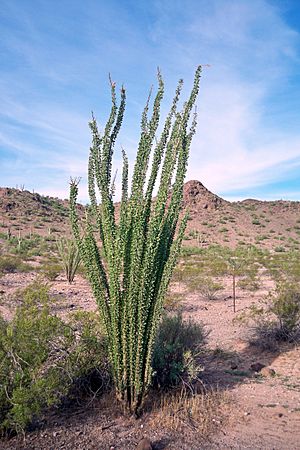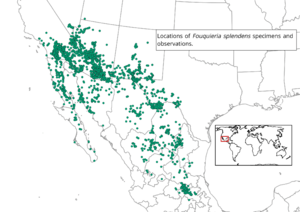Ocotillo facts for kids
Quick facts for kids Ocotillo |
|
|---|---|
 |
|
| Ocotillo near Gila Bend, Arizona | |
| Scientific classification | |
| Genus: |
Fouquieria
|
| Species: |
splendens
|
| Synonyms | |
|
Fouquieria spinosa Torr. |
|
The Fouquieria splendens is a unique desert plant. It's usually called ocotillo, but people also know it as coachwhip, candlewood, or desert coral. You can find this plant in the Sonoran Desert and Chihuahuan Desert. These deserts are located in the Southwestern United States (like California, Arizona, and Texas) and northern Mexico.
Even though it looks like a cactus with its spines, the ocotillo is actually more closely related to tea plants and blueberries! For most of the year, ocotillo plants look like a bunch of tall, spiny, dead sticks. But if you look closely, you'll see that the stems are partly green.
When it rains, the ocotillo quickly grows small, oval-shaped leaves (about 2–4 cm long). These leaves can stay on the plant for weeks or even months. Each stem can grow up to 5 cm wide at its base. The whole plant can reach a height of 10 m (about 33 ft), which is as tall as a three-story building! The plant branches out a lot from its base, but the branches above that are usually straight and tall, like poles. The parts where the leaves used to be turn into blunt spines. New leaves then grow from the base of these spines.
Bright red flowers appear on the tips of each mature stem. This often happens after rainfall in spring, summer, and sometimes even fall. These flowers are pollinated by hummingbirds and native carpenter bees.
Contents
Where Ocotillo Grows
Ocotillo plants live in the desert areas of the southwestern United States and central Mexico. They prefer dry, often rocky, soils.
How to Grow Ocotillo
You can plant ocotillo almost any time of the year, but it needs careful handling. The best way to grow them is from plants that have been started in pots from stem cuttings or seeds. Trying to move large plants that have been growing in the ground (called "bare-root" plants) doesn't always work well.
When planting, make sure the ocotillo is placed at the same depth it was growing before. It's also important to plant it facing the same direction it originally grew. The side of the plant that faced south became used to more heat and sunlight. If you don't plant it facing the same way, it might not grow as well.
Uses of Ocotillo
Ocotillo plants have several interesting uses:
- Living Fences: Sometimes, individual ocotillo stems are used as poles to build fences in their native areas. These poles can even take root and grow, forming a "living fence"!
- Walking Sticks: Because their branches are light and have cool patterns, ocotillo branches are sometimes made into canes or walking sticks.
- Food: The fresh flowers of the ocotillo can be added to salads and have a tangy taste.
- Herbal Tea: The flowers are also collected, dried, and used to make herbal teas (called tisanes).
- Traditional Medicine: Native Americans have used ocotillo flowers and roots on fresh wounds to help stop bleeding. People have also used baths with crushed flowers or roots to help with tiredness.
Gallery
-
Ocotillo forest in the Santa Rita Mountains of Arizona
-
A close-up of ocotillo thorns in Anza-Borrego Desert State Park
-
Ocotillo covered with rare snow in Tucson, Arizona
-
Ocotillo in full bloom near Lookout Mountain, Phoenix, Arizona
-
Ocotillo with leaves outside Tucson Mountains after a rainfall
-
Ocotillo plant in Joshua Tree National Park
Images for kids
-
Ocotillo in the City of Rocks State Park's desert botanical garden
See also
 In Spanish: Ocotillo para niños
In Spanish: Ocotillo para niños














